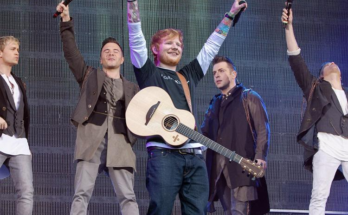On October 23, 1998, in a striking blend of music, fashion, and social consciousness, Madonna delivered an unforgettable performance at the VH1 and Vogue Fashion Awards. Marking the live debut of her haunting ballad “The Power of Good-Bye,” the Queen of Pop took the stage dressed in a commanding ensemble of black latex and leather. Her outfit, sleek and sharp, was both a nod to the avant-garde fashion world and a symbolic suit of emotional armor, as she sang one of her most introspective songs to date. The performance was elevated even further by the presence of the young string musicians from the Opus 118 Harlem School of the Arts—children whose talent and spirit added raw emotion to the minimalist, melancholic arrangement.
This singular performance was more than a live music debut; it was a cultural moment, emblematic of Madonna’s ability to fuse artistry, social relevance, and theatricality into one cohesive vision. It cemented “The Power of Good-Bye” not only as a standout track from her then-latest album Ray of Light, but as a timeless song of loss, acceptance, and inner strength.
The Context: Ray of Light and a New Madonna
By 1998, Madonna was undergoing a renaissance. Ray of Light, released in February of that year, showcased a spiritual and sonic evolution for the pop icon. Embracing electronica, ambient sounds, and introspective lyrics, the album was a radical departure from her earlier, more provocative pop work. Collaborating with producer William Orbit, Madonna explored themes of motherhood, self-awareness, and emotional detachment with a maturity that resonated with both critics and fans.
“The Power of Good-Bye” was one of the standout tracks from the album. A melancholy meditation on letting go, the song juxtaposed ethereal production with raw, emotionally complex lyrics. It was at once mournful and empowering—a balancing act Madonna performed with rare grace.
The song’s official release as a single came just weeks before the Fashion Awards performance. While its music video, directed by Matthew Rolston and co-starring Croatian actor Goran Višnjić, had already stirred buzz with its cool-toned, almost Nordic aesthetic, it was Madonna’s live interpretation that would redefine the song’s emotional weight.
The Performance: Fashion, Form, and Feeling
On stage at the VH1/Vogue Fashion Awards—an event known for its theatrical flair and celebration of style—Madonna emerged as a stark figure against the elegant backdrop. Her black latex bodysuit and high-heeled boots channeled a dominatrix edge, while the form-fitting leather and slick hair gave her the aura of a fashion priestess. It was a deliberate, high-concept look: at once vulnerable and impenetrable.
Yet what truly softened and humanized the moment was the presence of the children from Opus 118, a string orchestra based in Harlem. Dressed in school uniforms and arranged behind Madonna, these young musicians brought an organic warmth to the synthesized electronica of the original track. Their violins swelled with feeling, drawing out the song’s sadness while also imbuing it with hope. It was a musical meeting of worlds—Madonna’s hyper-polished pop and the earnest emotion of community youth art.
The juxtaposition between the adult complexity of heartbreak and the innocence of childhood made the performance deeply poignant. It also subtly highlighted Madonna’s philanthropic and maternal instincts—she had become a mother two years prior, and her newfound role was beginning to shape both her music and public image.
Social Resonance: Uplifting Harlem’s Young Musicians
The inclusion of the Opus 118 children was not a mere artistic flourish. Founded by Roberta Guaspari, Opus 118 Harlem School of the Arts was a program born out of a belief in equal access to classical music training. By spotlighting these young musicians on a national platform, Madonna brought much-needed attention to the importance of arts education in underserved communities.
In the following years, Guaspari’s work would inspire the 1999 documentary Small Wonders, which Madonna herself helped promote. That film would later become the basis for Music of the Heart (1999), a Hollywood dramatization starring Meryl Streep. Madonna had initially been cast in the role before stepping down due to creative differences, but her support for the cause remained strong.
This commitment to social justice and education was increasingly evident in Madonna’s late-’90s and early-2000s work, from her involvement in children’s literacy campaigns to her founding of charitable organizations supporting education in Malawi.
Legacy: A Turning Point in Madonna’s Live History
Madonna’s performance of “The Power of Good-Bye” at the 1998 VH1/Vogue Fashion Awards was more than a live debut—it was a cultural statement. At a time when many pop artists relied on pyrotechnics and dance choreography, she opted for stillness, vulnerability, and raw musicality. That choice demonstrated her artistic fearlessness and her commitment to constantly redefining what a pop performance could be.
Critics lauded the performance for its emotional depth and stark beauty. Fans recall it as one of the most sincere and moving moments in Madonna’s long and varied career. It was also a powerful reminder of the potential for mainstream music to intersect with issues of class, education, and community.
Conclusion: A Moment That Endures
As the final notes of “The Power of Good-Bye” echoed through the audience that October night, Madonna stood momentarily still—flanked by children holding violins, bathed in blue light, wrapped in the metaphoric armor of latex and leather. In that moment, she was not just a pop icon or fashion muse. She was a storyteller, a mother, a patron of the arts, and a woman who had learned, through experience, the difficult strength it takes to say goodbye.
Today, that performance lives on not only as a compelling artistic statement but as a snapshot of Madonna at her most fearless—melding fashion, emotion, and advocacy into one unforgettable act.



